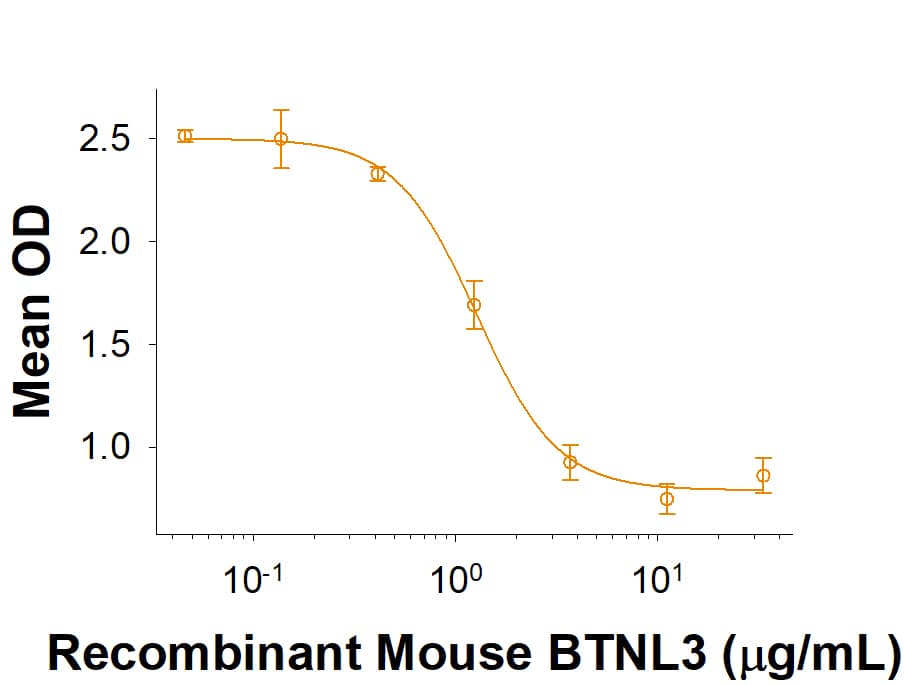Recombinant Mouse BTNL3 Fc Chimera Protein, CF
R&D Systems, part of Bio-Techne | Catalog # 10222-BT

Key Product Details
Source
Accession #
Structure / Form
Conjugate
Applications
Product Specifications
Source
| Recombinant Mouse BTNL3 (Glu28-Pro241) Accession # Q7TST0.3 |
IEGRMDP | Mouse IgG2a (Glu98-Lys330) |
| N-terminus | C-terminus |
Purity
Endotoxin Level
N-terminal Sequence Analysis
Predicted Molecular Mass
SDS-PAGE
Activity
The ED50 for this effect is 0.4-4 μg/mL.
Scientific Data Images for Recombinant Mouse BTNL3 Fc Chimera Protein, CF
Formulation, Preparation and Storage
10222-BT
| Formulation | Supplied as a 0.2 μm filtered solution in PBS. |
| Shipping | The product is shipped with dry ice or equivalent. Upon receipt, store it immediately at the temperature recommended below. |
| Stability & Storage | Use a manual defrost freezer and avoid repeated freeze-thaw cycles.
|
Background: BTNL3
Butyrophilin-like 3 (BTNL3), also referred to as BTNL1, Gm316, and Ng10, is a member of the BTN/MOG Ig-superfamily and shares structural resemblance to the B7 family (1). BTNL3 is a type I transmembrane protein that consists of an extracellular domain (ECD) containing two IgV domains, a single transmembrane domain, and a cytoplasmic domain with a B30.2/SPRY region. Mature mouse BTNL3 shares 30% and 80% amino acid sequence identity with human and rat BTNL3, respectively. BTNL3 mRNA has been identified in many tissues including small intestine, colon, liver, lung, bone marrow and spleen tissue, and it is highly expressed in neutrophils (2-6). The specific function of BTNL3 has yet to be fully elucidated, but BTNL3 is suggested to be a novel negative regulator for T cell activation and immune diseases (7). In humans, BTNL3 has been shown to form heterodimers with BTNL8 and overexpression of this complex leads to CD69 upregulation and T cell antigen receptor downregulation (8). In mice, BTNL3 can form heterodimers with BTNL6 and modulate local immune responses and intraepithelial lymphocytes–epithelial cell interaction pathways (9). Additionally, BTNL3 has been shown to bind directly to V gamma4+ T cell receptor, suggesting a role in gamma delta T cell regulation (10). BTNL3 expression has also been found to be down-regulated in colon cancer tumors (11). R&D Systems in house data indicate that mouse BTNL3 protein inhibits the secretion of IL-2 from anti-CD3 activated mouse CD3+ T cells.
References
- Shibui, A. et al. (1999) J. Hum. Genet. 44:249.
- Arnett, H.A. et al. (2014) Nat Rev Immunol. 14:5596.
- Arnett, H.A. et al. (2009) Cytokine 46:370.
- Abeler-Dorner, L. et al. (2012) Trends Immunol. 33:34.
- Rhodes, D. et al. (2016) Annu. Rev. Immunol. 34:151.
- Guo, Y and Wang, AY (2015) Front. Immunol. 6:421.
- Yamazaki, T. et al. (2010) J Immunol 185:5907.
- Melandri, D. et al. (2018) Nat Immunol 19:1352.
- Lebrero-Fernández, C. et al. (2016) Front Immunol. 7:1.
- Wilcox, C.R. et al. (2019) Immunity 51:813.
- Lebrero-Fernandez, C. et al. (2016) Immun. Inflammation Dis. 4:191.
Long Name
Alternate Names
Gene Symbol
UniProt
Additional BTNL3 Products
Product Documents for Recombinant Mouse BTNL3 Fc Chimera Protein, CF
Product Specific Notices for Recombinant Mouse BTNL3 Fc Chimera Protein, CF
For research use only

